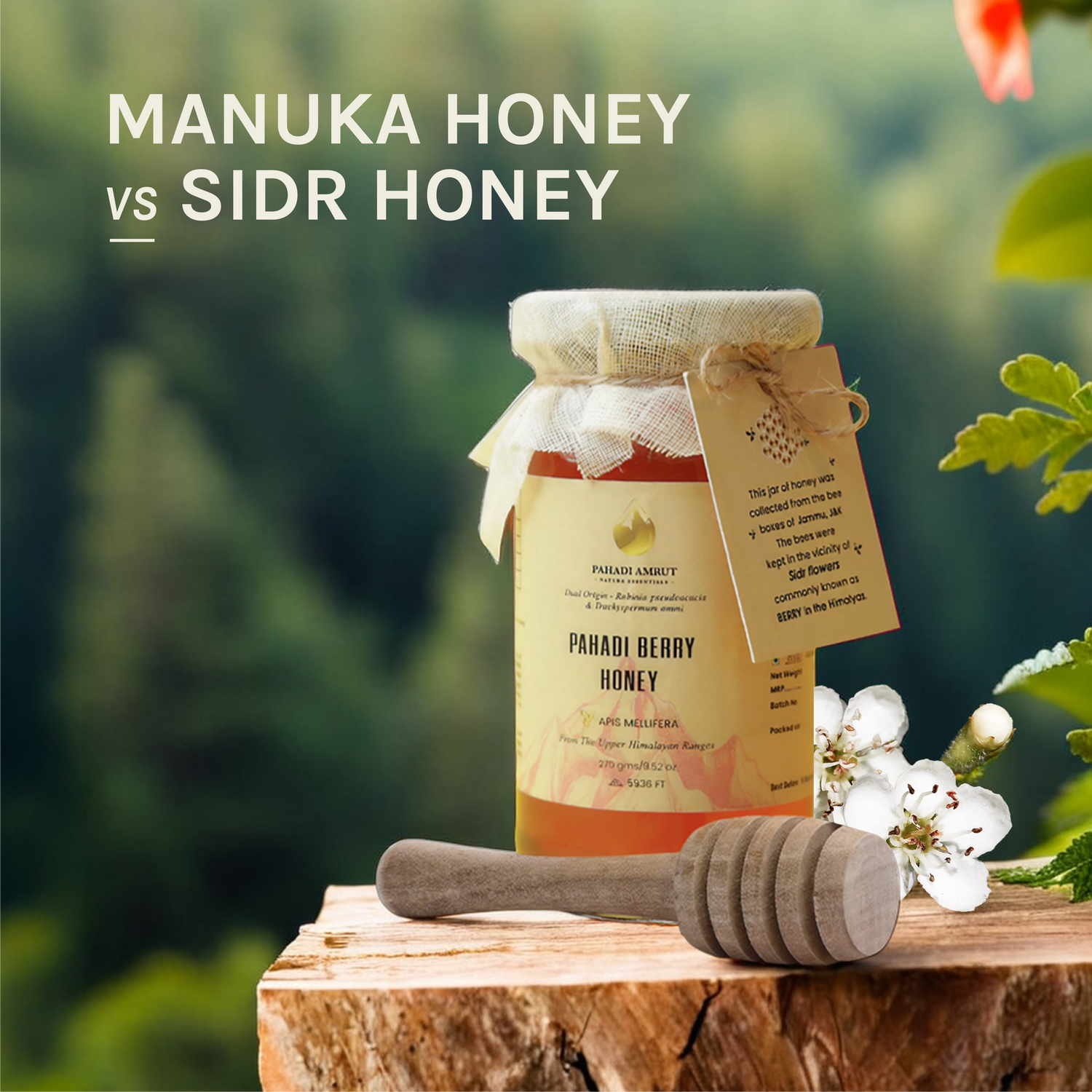Honey is one of nature’s greatest gifts, revered for its medicinal and nutritional properties for centuries.
From boosting immunity to aiding digestion and enhancing skin health, this golden nectar is packed with bioactive compounds that offer a wealth of benefits.
However, not all honey is created equal.
Among the most sought-after varieties, Manuka Honey and Sidr Honey stand out due to their exceptional purity, potency, and healing properties.
But how do they compare?
Which one is better for you?
Let’s dive into the details of Manuka Honey Vs Sidr Honey.
About Manuka Honey
Manuka honey is a special type of honey produced by bees that collect nectar from the Manuka tree (Leptospermum scoparium), which grows in New Zealand and parts of Australia. It is well-known for its powerful antibacterial, anti-inflammatory, and healing properties.
What makes Manuka honey unique is its high level of Methylglyoxal (MGO), a compound responsible for its strong medicinal benefits. It has been used for centuries in traditional medicine and is now widely recognized for its health benefits.
Properties of Manuka Honey
Manuka honey has several unique characteristics that set it apart from regular honey:
High MGO Content
Manuka honey contains Methylglyoxal (MGO), which gives it strong antibacterial properties. The higher the MGO level, the stronger the honey's ability to fight bacteria.
Unique Manuka Factor (UMF)
The UMF rating is a grading system that measures the purity and strength of Manuka honey. It ensures the honey contains MGO, DHA (Dihydroxyacetone), and Leptosperin, all essential for its medicinal benefits.
Rich in Antioxidants
Manuka honey contains phenolic compounds, which neutralize harmful free radicals and reduce oxidative stress in the body. These antioxidants help support immunity, skin health, and overall well-being.
Thick, Dark Texture
Unlike regular honey, Manuka honey has a thick, creamy consistency and a dark amber color. It has a rich, earthy flavor with a mild medicinal taste due to its high MGO content.
Anti-Inflammatory Properties
Scientific studies show that Manuka honey reduces inflammation by stimulating the body’s natural healing processes. It enhances the production of immune-boosting cytokines like TNF-α, IL-1β, and IL-6, which help fight infections and speed up recovery.
Process of Cultivation
The production of Manuka Honey is a carefully controlled process to ensure purity and potency. The Manuka tree blooms for only 2 to 6 weeks a year, making this honey rare and highly seasonal.
During this short period, bees collect nectar from the tiny white or pink Manuka flowers. Inside the hive, the nectar naturally transforms, where DHA (Dihydroxyacetone) gradually converts into MGO (Methylglyoxal), giving Manuka Honey its unique antibacterial properties.
Once the honeycombs are full, beekeepers carefully harvest the honey, ensuring minimal processing to preserve its active compounds.
Benefits of Manuka Honey
Manuka honey is a powerful medicinal honey with scientifically backed health benefits as it contains Methylglyoxal (MGO), a compound that gives it strong antibacterial, anti-inflammatory, and healing properties.
From wound healing to digestive health, here’s a deep dive into the top benefits of Manuka honey.
Speeds Up Wound Healing
Manuka honey has been used for centuries to treat wounds, burns, and infections. Its antibacterial and antioxidant-rich nature creates a moist healing environment, which prevents microbial infections and promotes faster recovery.
Studies confirm that Manuka honey enhances tissue regeneration and reduces pain in burn patients. It is also effective against antibiotic-resistant bacteria like MRSA (Methicillin-resistant Staphylococcus aureus), making it useful in modern medicine.
Supports Oral Health
Unlike regular sugar, Manuka honey does not contribute to cavities. Instead, it helps protect against gum disease, plaque buildup, and tooth decay.
Research shows that Manuka honey inhibits harmful oral bacteria like Porphyromonas gingivalis and Aggregatibacter actinomycetemcomitans, both responsible for gum inflammation and decay. It soothes sore throats and mouth ulcers, making it a natural remedy for oral care.
Soothing for Coughs & Sore Throats
Manuka honey is a proven remedy for upper respiratory tract infections (URIs), including colds, flu, and bronchitis.
Studies suggest that honey is more effective than common cough medicines in reducing cough frequency and severity. Its antibacterial and anti-inflammatory effects coat the throat, reducing irritation and soothing discomfort.
May Help Prevent Stomach Ulcers
Gastric ulcers are painful sores in the stomach lining, often caused by Helicobacter pylori (H. pylori) bacteria. Manuka honey may help reduce the risk of ulcers by fighting these bacteria.
A study found that people who consumed honey more than five times a week had a significantly lower risk of H. pylori infection. Regular Manuka honey consumption may also lower the risk of peptic ulcers and even gastric cancer.
Improves Digestive Health
Manuka honey promotes gut health by reducing inflammation and fighting harmful bacteria. It may help with acid reflux, bloating, irritable bowel syndrome (IBS), and stomach pain.
Studies show it can control Clostridium difficile (C. diff), a bacteria that causes severe diarrhea and bowel inflammation.
Also Read: Is Manuka Honey Worth the High Price?
About Sidr Honey
Sidr Honey, also known as Berry Honey, is a rare and highly prized honey derived from the nectar of Robinia pseudoacacia (Black Locust) and Trachyspermum ammi (Ajwain) plants, giving it unique medicinal properties. It is known for its rich, caramel-like taste, thick texture, and exceptional medicinal properties.
This honey is considered one of the finest and most potent honey in the world, particularly due to its high antioxidant, antibacterial, and anti-inflammatory properties. Harvested from the untouched Himalayan ranges and Middle Eastern valleys, Sidr Honey is revered for its purity and health benefits.
Properties of Sidr Honey
Sidr Honey is unique due to its complex composition and high nutritional value.
Powerful Antibacterial & Antimicrobial Properties
Sidr Honey is known for its strong antibacterial action, making it effective against infections, wounds, and digestive issues. Studies show it has properties similar to Manuka Honey, with the ability to combat antibiotic-resistant bacteria.
Rich in Antioxidants & Minerals
Contains flavonoids and polyphenols, which protect cells from oxidative stress and aging. Packed with essential vitamins and minerals, including calcium, magnesium, iron, and potassium.
Distinctive Taste & Texture
It has a deep, amber-red color and a thick, viscous consistency. The taste is rich, sweet, and caramel-like, with slight molasses notes and a mild bitterness, making it one of the most flavorful honeys.
Natural Energy Booster
Due to its high carbohydrate and mineral content, it provides a sustained energy release without the sugar crash of refined sugars.
Anti-Inflammatory & Healing Properties
Used in traditional medicine to treat respiratory, digestive, and immune system disorders. Contains natural enzymes and organic compounds that aid in healing wounds, soothing sore throats, and improving skin health.
Process of Cultivation
The production of Sidr Honey is a specialized and carefully managed process to ensure purity and high quality. The Sidr trees and berry plants grow in remote, untouched regions, far from pollutants and pesticides.
Bees collect nectar from Robinia pseudoacacia (Black Locust) and Trachyspermum ammi (Ajwain) plants, giving Sidr Honey its powerful medicinal benefits.
To protect the natural ecosystem, beekeepers use ethical and traditional methods, placing hives in pristine Himalayan valleys and Middle Eastern desert regions. The honey is extracted manually, ensuring it remains raw and unprocessed. Unlike commercial honey, Sidr Honey is not heated or overly filtered, preserving its natural enzymes, pollen, and antioxidants.
Also Read: Different Types of Honey And Their Benefits
Benefits of Sidr Honey
Sidr Honey, also known as Berry Honey, is a rare and highly medicinal honey known for its antibacterial, antioxidant, and anti-inflammatory properties.
Unlike regular honey, Sidr Honey is rich in bioactive compounds that contribute to its numerous health benefits.
Antimicrobial Properties
Sidr honey exhibits potent antibacterial and antiviral activities. Studies have demonstrated its efficacy against various pathogens, including antibiotic-resistant strains like methicillin-resistant Staphylococcus aureus (MRSA). This makes it a valuable natural alternative for combating infections.
Antioxidant Activity
Rich in phenolic compounds and flavonoids, Sidr honey serves as a robust antioxidant. These antioxidants neutralize free radicals in the body, reducing oxidative stress and potentially lowering the risk of chronic diseases such as heart disease and cancer.
Anti-Inflammatory Effects
The anti-inflammatory properties of Sidr honey can assist in alleviating symptoms of various inflammatory conditions. Its consumption may help reduce inflammation, providing relief in ailments like arthritis and promoting overall health.
Wound Healing
Applied topically, Sidr honey has been effective in accelerating the healing of wounds, burns, and skin infections. Its natural enzymes and antibacterial properties create a protective barrier, keeping wounds moist and preventing microbial growth, which facilitates faster healing.
Digestive Health
Sidr honey acts as a prebiotic, resulting in the growth of beneficial gut bacteria. This can improve digestion, alleviate gastrointestinal disorders such as gastritis and ulcers, and enhance nutrient absorption, contributing to overall digestive wellness.
Incorporating Sidr honey into your daily routine, whether as a natural sweetener or a topical agent, can provide these health benefits.
Manuka Honey vs. Sidr Honey: Which One is Better for You?
Both Manuka Honey and Sidr Honey are highly prized for their medicinal and health benefits, but they come from different botanical sources and regions.
Both are rich in antibacterial, antioxidant, and anti-inflammatory properties, making them excellent choices for improving health, immunity, and wound healing. However, they differ in taste, texture, medicinal strength, and cost. Below is a detailed comparison:
|
Feature |
Manuka Honey |
Sidr Honey |
|
Origin |
New Zealand, Australia |
Yemen, Saudi Arabia, Himalayan regions |
|
Source Plant |
Manuka bush (Leptospermum scoparium) |
Sidr tree (Ziziphus spina-christi) or Robinia pseudoacacia (Black Locust) and Trachyspermum ammi (Ajwain) |
|
Main Active Compound |
Methylglyoxal (MGO) – Strong antibacterial agent |
Phenolic compounds & flavonoids – High in antioxidants |
|
Taste Profile |
Earthy, medicinal, slightly bitter taste |
Rich, sweet, caramel-like with mild bitterness |
|
Texture & Appearance |
Thick, creamy, dark amber in color |
Thick, golden-amber or deep red in color |
|
Price & Rarity |
Expensive due to strict quality testing & limited production |
Expensive due to scarcity and high demand |
|
Cultural & Historical Importance |
Used in traditional Maori medicine and modern hospitals |
Mentioned in ancient Islamic medicine, Ayurvedic, and highly valued in Middle Eastern culture |
The choice between Manuka Honey and Sidr Honey ultimately depends on your personal preferences and health goals. However, no matter which honey you choose, always ensure that it is raw, pure, and unadulterated to experience the full spectrum of its natural benefits.
For those seeking authentic Himalayan honey, we offer 100% pure Sidr Honey, known as Berry Honey, sourced from the untouched Himalayan ranges.
Buy Pure Sidr Honey From Pahadi Amrut
When it comes to choosing between Manuka Honey vs. Sidr Honey, the most important factor is quality and authenticity. While standard Sidr Honey is extracted from a single-origin tree (Sidr tree – Ziziphus spina-christi), Pahadi Amrut’s Sidr Honey or Berry Honey is truly unique.
Our dual-origin honey is carefully harvested from the unpolluted Himalayan ranges at altitudes exceeding 5000 feet, making it richer, purer, and more potent than conventional Sidr Honey.
Sourced from the nectars of Robinia pseudoacacia (Black Locust) and Trachyspermum ammi (Ajwain), our honey captures the combined benefits of both plants, delivering a powerful fusion of antioxidants, antibacterial properties, and natural vitality.
Each batch of Berry Honey is:
-
100% Raw & Unprocessed – No heat, no additives, just pure honey as nature intended.
-
Sustainably Harvested – Collected using traditional, ethical beekeeping methods.
-
Lab-Tested for Purity & Potency – Ensuring every jar is rich in nutrients and medicinal compounds.
-
Carefully Packed to Retain Freshness – Sealed with care to preserve its natural goodness.
Experience the rarest and most powerful Himalayan Sidr Honey. Choose Pahadi Amrut’s Berry Honey—a true gift of nature.



